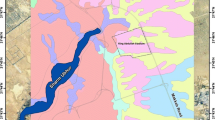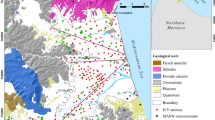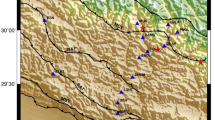Abstract
Earthquakes are an inevitable event, and the frequency of them is increasing in recent years. Various countries carry out seismic microzonation and specific site studies in order to reduce the possible future effects of earthquakes. For doing so, subsurface information is needed, but seismic site classifications given by many researchers did not include such information. So in this study, subsurface information like sediment thickness obtained from boreholes of Uttarakhand was used for seismic site classification. Also, various correlation studies were conducted between parameters of horizontal to vertical spectral ratio (HVSR) curve, seismic parameters, and aquifer parameters. Some of the correlation studies have been carried out for the first time like resonance frequency with water table depth and for amplitude with aquifer depth. In total, all these correlation studies provide a basis for future studies in the Uttarakhand region.











Similar content being viewed by others
References
Anbazhagan P, Srilakshmi KN, Bajaj K, Moustafa SSR, Al-Arifi NSN (2018) Determination of seismic site classification of seismic recording stations in the Himalayan region using HVSR method. Soil Dyn Earthq Eng 116:304–316. https://doi.org/10.1016/j.soildyn.2018.10.023
Anbazhagan P, Boobalan AJ, Shaivan HS (2019) Establishing empirical correlation between sediment thickness and resonant frequency using HVSR for the Indo-Gangetic Plain. Curr Sci 117(9):1482–1491
Anthiraikili JB (2020) Establishing empirical equation for resonant frequency vs sediment thickness using Nakamura or H/V ratio method in Indo-Gangetic Plain. Arab J Geosci 13(6):1–15
Bhattacharya AR, Weber K (2004) Fabric development during shear deformation in the Main Central Thrust zone, NW-Himalaya, India. Tectonophysics 387(1-4):23–46
Birgören G, Özel O, Siyahi B (2009) Bedrock depth mapping of the coast south of Istanbul: comparison of analytical and experimental analyses. Turk J Earth Sci 18(2):315–329
Biswas R, Baruah S, Bora DK (2015) Mapping sediment thickness in Shillong City of Northeast India through empirical relationship. J Earthq 2015:1–8
Borcherdt RD (1994) Estimates of site-dependent response spectra for design (methodology and justification). Earthquake Spectra 10(4):617–653
BSSC. Building Seismic Safety Council (2003) NEHRP recommended provisions for seismic regulations for new buildings and other structures. Report FEMA-450 (Provisions). Federal Emergency Management Agency (FEMA), Washington
Chopra S, Kumar V, Choudhury P, Yadav RBS (2018) Site classification of Indian strong motion network using response spectra ratios. J Seismol 22(2):419–438
Del Monaco F, Durante F, Macerola L, Tallini M (2014) Quaternary sedimentary cover thickness versus seismic noise resonance frequency In Western L’aquila Plain. GNGTS Session 2.2
Delgado J, Casado CL, Giner J, Estevez A, Cuenca A, Molina S (2000) Microtremors as a geophysical exploration tool: applications and limitations. Pure Appl Geophys 157(9):1445–1462
Dikmen Ü (2009) Statistical correlations of shear wave velocity and penetration resistance for soils. J Geophys Eng 6(1):61–72
Dinesh BV, Nair GJ, Prasad AGV, Nakkeeran PV, Radhakrishna MC (2010) Estimation of sedimentary layer shear wave velocity using micro-tremor H/V ratio measurements for Bangalore city. Soil Dyn Earthq Eng 30(11):1377–1382
Fnais MS, Abdelrahman K, Al-Amri AM (2010) Microtremor measurements in Yanbu city of western Saudi Arabia: a tool for seismic microzonation. J King Saud Univ-Sci 22(2):97–110
Harinarayan NH, Kumar A (2018) Determination of NEHRP site class of seismic recording stations in the Northwest Himalayas and its adjoining area using HVSR method. Pure Appl Geophys 175(1):89–107
Hinzen KG, Weber B, Scherbaum F (2004) On the resolution of H/V measurements to determine sediment thickness, a case study across a normal fault in the Lower Rhine Embayment, Germany. J Earthq Eng 8(6):909–926
Hosono T, Yamada C, Manga M, Wang CY, Tanimizu M (2020) Stable isotopes show that earthquakes enhance permeability and release water from mountains. Nat Commun 11(1):1–9
Huang X, Zhang Y (2020) Various far-field hydrological responses during 2015 Gorkha earthquake at two distant wells. Earth Planet Space 73(1):1–23
Ibs-von Seht M, Wohlenberg J (1999) Microtremor measurements used to map thickness of soft sediments. Bull Seismol Soc Am 89(1):250–259
Kagabu M, Ide K, Hosono T, Nakagawa K, Shimada J (2020) Describing coseismic groundwater level rise using tank model in volcanic aquifers, Kumamoto, southern Japan. J Hydrol 582:124464
Khan S, Khan MA (2016) Mapping sediment thickness of Islamabad city using empirical relationships: implications for seismic hazard assessment. J Earth Syst Sci 125(3):623–644
Kim J, Joun WT, Lee S, Kaown D, Lee KK (2020) Hydrogeochemical evidence of earthquake-induced anomalies in response to the 2017 MW 5.5 Pohang earthquake in Korea. Geochem Geophys Geosyst 21(12):e2020GC009532
Krogulec E, Małecki JJ, Porowska D, Wojdalska A (2020) Assessment of causes and effects of groundwater level change in an urban area (Warsaw, Poland). Water 12(11):3107
Lee SH, Cheong JY, Park YS, Ha K, Kim Y, Kim SW, Hamm SY (2017) Groundwater level changes on Jeju Island associated with the Kumamoto and Gyeongju earthquakes. Geomatics Nat Hazards Risk 8(2):1783–1791
Meldebekova G, Yu C, Li Z, Song C (2020) Quantifying ground subsidence associated with aquifer overexploitation using space-borne radar interferometry in Kabul, Afghanistan. Remote Sens 12(15):2461
Micenko M (2019) Cimatti field–an example of using seismic amplitude to determine in-place resource. ASEG Extended Abstr 1:1–4
Mittal H, Kumar A, Ramhmachhuani R (2012) Indian national strong motion instrumentation network and site characterization of its stations. Int J Geosci 3(6):1151–1167
Özalaybey S, Zor E, Ergintav S, Tapırdamaz MC (2011) Investigation of 3-D basin structures in the Izmit Bay area (Turkey) by single-station microtremor and gravimetric methods. Geophys J Int 186(2):883–894
Parolai S, Bormann P, Milkereit C (2001) Assessment of the natural frequency of the sedimentary cover in the Cologne area (Germany) using noise measurements. J Earthq Eng 5(4):541–564
Parolai S, Bormann P, Milkereit C (2002) New relationships between Vs, thickness of sediments, and resonance frequency calculated by the H/V ratio of seismic noise for the Cologne area (Germany). Bull Seismol Soc Am 92(6):2521–2527
Paudyal YR, Yatabe R, Bhandary NP, Dahal RK (2013) Basement topography of the Kathmandu Basin using microtremor observation. J Asian Earth Sci 62:627–637
Pride SR, Harris JM, Johnson DL, Mateeva A, Nihel KT, Nowack RL et al (2003) Permeability dependence of seismic amplitudes. Lead Edge 22(6):518–525
Sharma ML, Douglas J, Bungum H, Kotadia J (2009) Ground-motion prediction equations based on data from the Himalayan and Zagros regions. J Earthq Eng 13(8):1191–1210
Ullah I, Prado RL (2017) Soft sediment thickness and shear-wave velocity estimation from the H/V technique up to the bedrock at meteorite impact crater site, Sao Paulo city, Brazil. Soil Dyn Earthq Eng 94:215–222
Wald DJ, Allen TI (2007) Topographic slope as a proxy for seismic site conditions and amplification. Bull Seismol Soc Am 97(5):1379–1395
Wang CY, Manga M (2010) Earthquakes influenced by water. In: Earthquakes and Water. Springer, Berlin, Heidelberg, pp 125–139
Wang CY, Dreger DS, Wang CH, Mayeri D, Berryman JG (2003) Field relations among coseismic ground motion, water level change and liquefaction for the 1999 Chi-Chi (Mw = 7.5) earthquake, Taiwan. Geophys Res Lett 30(17)
Wong A, Wang C Y (2007) Field relations between the spectral composition of ground motion and hydrological effects during the 1999 Chi‐Chi (Taiwan) earthquake. J Geophys Res: Solid Earth 112(B10):1–4
Acknowledgements
We would like to thank the vice-chancellor and director from the School of Fishery Environment, Dr. Subash Chandran, and director from School of Ocean Science and Technology, Prof. Suresh Kumar, KUFOS, for their constant encouragement. This research did not receive any specific grant from funding agencies in the public, commercial, or not-for-profit sectors.
Author information
Authors and Affiliations
Corresponding author
Ethics declarations
Conflict of interest
The authors declare that they have no competing interests.
Additional information
Responsible Editor: Longjun Dong
Rights and permissions
About this article
Cite this article
Anthiraikili, J.B., Das, H.H. Site classification and correlation study of HVSR curve with seismic and aquifer parameters of strong-motion sites in Uttarakhand, India. Arab J Geosci 14, 1553 (2021). https://doi.org/10.1007/s12517-021-08046-7
Received:
Accepted:
Published:
DOI: https://doi.org/10.1007/s12517-021-08046-7




